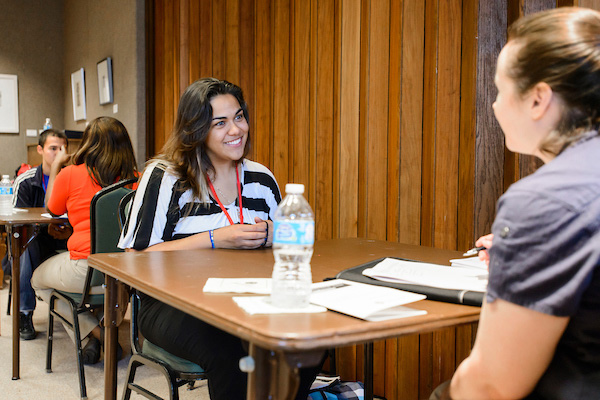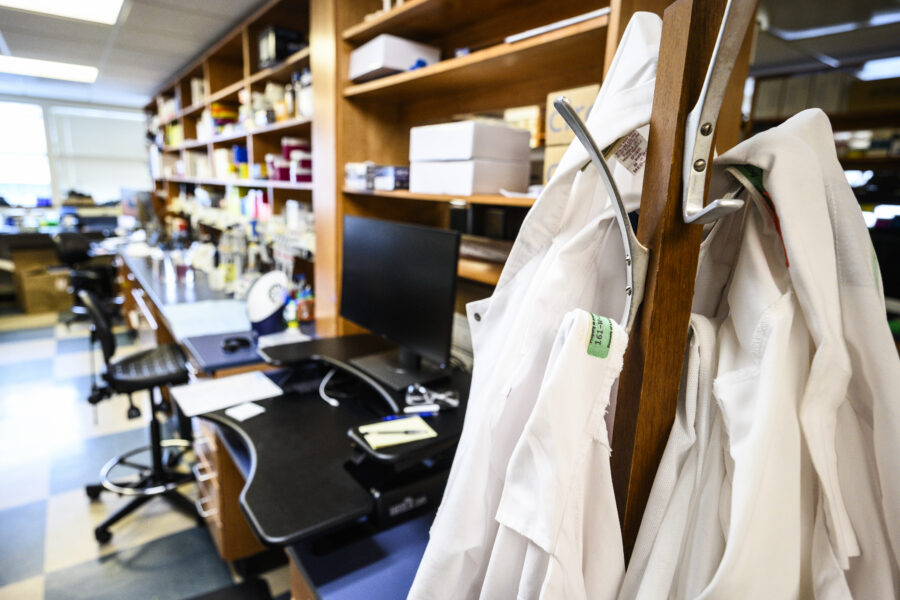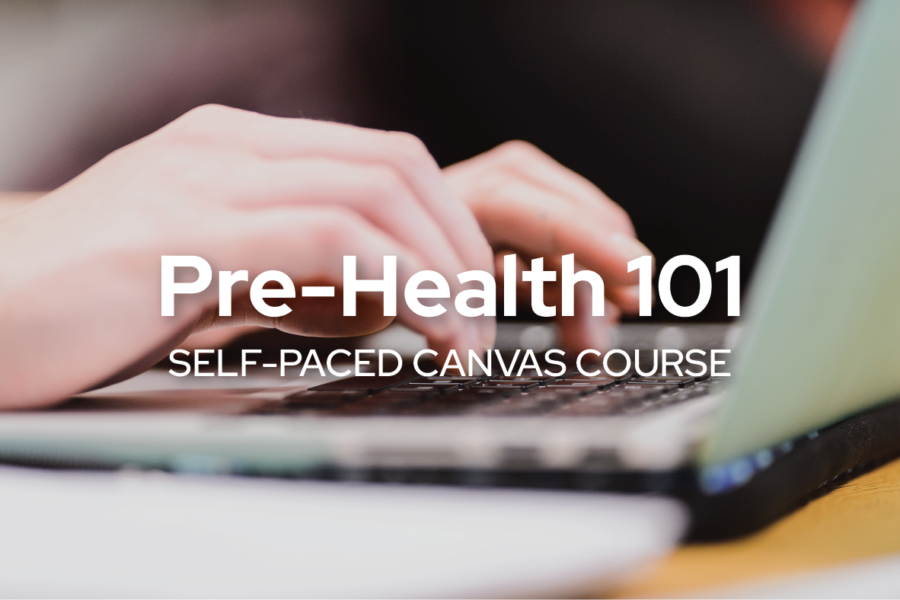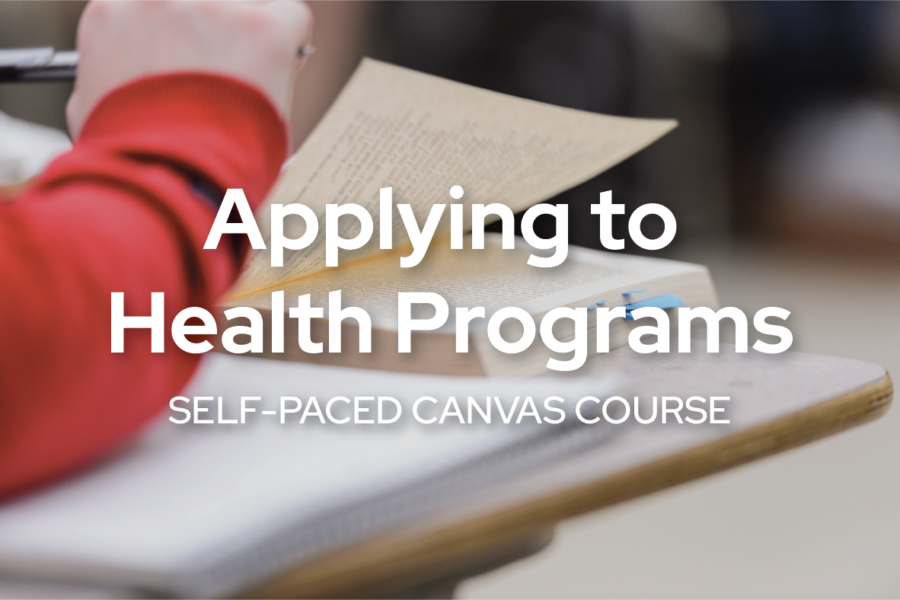About Optometry
Optometrists are doctors of optometry (ODs) and are independent primary healthcare professionals for the eye. Optometry programs are 4 year graduate programs where you learn the fundamentals of examining, diagnosing, treating, and managing diseases, injuries, and disorders of the visual system, the eye, and conditions affecting the eye. Optometrists may be generalists who work with a wide variety of patients or they may be specialists who focus on a particular population or issue. Many aspiring optometrists elect courses in business because optometry is a field where many professionals own their own practice or create a limited liability corporation with other optometrists.
Explore Your Interest in Optometry
Shadowing & Informational Interviews
An excellent way to explore your interest in optometry is by observing providers. Shadowing optometrists shows you what their day is like and how they work with patients.
Volunteering
Optometry programs look for applicants who demonstrate a sustained commitment to serving others. Learn more about opportunities to volunteer in clinical and non-clinical settings.
Jobs
Getting a job as an optometry technician is a great way to learn about the practical aspects of the field. Confirm that this work is something you enjoy!
Preparing for Optometry School
Optometry schools use a process called holistic review to weigh personal factors, academic preparation, and professional experience when reviewing an applicant’s “readiness” for optometry. Put together, these create a picture of you as a whole person.
In addition to having a clear motivation for the field, completing required coursework, shadowing, experience in clinical and community settings, hobbies and interests, and taking the Optometry Admissions Test (OAT) are common admissions factors for optometry schools.
The Association of Schools and Colleges of Optometry (ASCO) list school-specific prerequisites on their Applicant/Student Profile and Prerequisites page. Required courses may include:
Optometry Required Coursework
| Topic | Credits/Semesters | UW-Madison Courses | Is AP Accepted? |
|---|---|---|---|
| Biology | 8-10 credits or 1-2 semesters with labs | Choose one of the following sequences: Zoology 101-102 and an additional bioscience course with lab such as Botany 130, Anat&Phy 335/435, OR Anat&Phy 337 AND 338) Biology 151-152 Biocore 381-382 AND 383-384 satisfies Intro to Bio requirements *Biocore: Students must apply to enroll in Biocore. For more information, visit their website. | If you have AP credit for Biology, plan to enroll in additional advanced Biology once you've finished your intro Biology sequence. |
| General Chemistry | 8-10 credits or 1-2 semesters with labs | Choose one of the following sequences: Chemistry 103-104 Chemistry 109* Chem 115-116 (intended for Chemistry majors) *Schools may accept Chem 109 as equivalent to two semesters of inorganic chemistry; some may ask for a letter from the UW-Madison Chemistry Department describing the condensed nature of Chem 109. See Pre-Health Advising for more information if you have taken Chem 109 | Schools may accept AP credit for Chem 103. |
| Organic Chemistry | 6-8 credits or 2 semesters Usually labs are required Some schools will accept 1 semester of Organic Chemistry with 1 semester of Biochemistry | Chem 343 Introductory Organic Chemistry Chem 345 Intermediate Organic Chemistry Chem 344 Introductory Organic Chemistry Lab | Not applicable |
| Physics | 8-10 credits or 2 semesters with labs | Choose one of the following sequences: Physics 103-104 (algebra-based) Physics 201-202 (calculus-based; recommended for Engineering majors) Physics 207-208 (calculus-based; recommended for Life Science majors) * If physics is required for your major, select the sequence recommended by your major. If physics is not required by your major, physics 103-104 is an appropriate choice | Most schools will accept AP credit for at least one physics course. |
| Biochemistry | 3 credits or 1 semester | Choose one of the following courses: Biochemistry 501 Biochemistry 507-508 (intended for Biochem majors) | Not Applicable |
| Math | 3-5 credits or 1 semester | Choose one of the following: Math 171 & 217 Math 221 Math 211 | Varies widely; taking a math class at the college level is advised |
| Statistics | 3 credits or 1 semester | Stats 301 Stats 371 An Introductory Stats course in your major department | If you have AP credit for Stats 301, consider taking 240 or 371 |
| Social Science | 3 credits or 1 semester | If you have credit for AP psych, plan on taking additional psych | |
| Humanities | Plan on taking 6 credits of English. | Learn more: English Requirements for Health Programs | If you have AP English, you should take higher level English classes in college. |
| Strongly Recommended | |||
| Anatomy/Physiology | 8-10 credits * Sometimes required * Labs sometimes required | Anat/Phys 337 & 338 AND Anat/Phys 335 | |
| Microbiology | 3-5 credits | Microbiology 101/102 OR Microbiology 303/304 |
Working or volunteering in clinics, and other healthcare settings gives you a chance to work with patients and healthcare teams and is extremely valuable for pre-health students, in general. For Optometry, working or volunteering in an eye clinic or optometry setting is a priority since many optometry schools strongly recommend or require shadowing or experience in the setting.
Optometry programs look for applicants who demonstrate a sustained commitment to serving others in healthcare and community settings. Learn more about service opportunities by visiting our Volunteering page and choose opportunities and organizations aligned with your interests!
Research is an important way to develop skills that help you hone your capacity to learn and begin to contribute to the generation of new knowledge in fields of inquiry. Working in a research lab also gives you the opportunity to cultivate relationships with faculty who can serve as letter writers when you apply to a health professions program.
CPHA is here to help with the OAT! Enroll in CPHA’s Applying to Health Professions self-paced course to learn more about the OAT.
What is the OAT?
The Optometry College Admission Test (OAT) is a standardized content exam designed to assess your content knowledge in areas of biology, chemistry, physics, and quantitative skills as well as your ability to reason through scientific research, evaluate data, and analyze writing from a broad range of topics. Here is an overview of the test day and how the content areas are distributed on the exam. You are not penalized for guessing on the OAT and raw scores are converted to scaled scores to adjust for differences in each exam. Scaled scores are reported within a range of 200-400 in increments of 10.
- Natural Science (100 items) includes (40) questions about biology, (30) questions about general chemistry, and (30) questions about organic chemistry.
- Reading Comprehension (50 items) contains three reading passages on various scientific topics.
- Physics (40 items) contains questions on units and vectors, linear kinematics, statics, dynamics, rotational motion, energy and momentum, simple harmonic motion, waves, fluid statics, thermal energy and thermodynamics, electrostatics, D.C. circuits, and optics.
- Quantitative Reasoning (40 items) includes algebra, data analysis, quantitative comparison, probability, statistics, and math word problems.
OAT Exam Overview
| Section | Number of Questions | Time Allotted |
|---|---|---|
| Optional Tutorial | 15 minutes | |
| Section 1: Natural Science | 100 | 90 minutes |
| Section 2: Reading Comprehension | 50 | 60 minutes |
| Optional Break | 30 minutes | |
| Section 3: Physics | 40 | 50 minutes |
| Section 4: Quantitative Reasoning | 40 | 50 minutes |
| Optional Survey | 15 minutes | |
| Total Content Time | 4 hours, 5 minutes | |
| Total Test Time | 5 hours, 5 minutes |
Before the OAT: Recommended Coursework
The OAT is a content based exam meaning you need certain courses before taking it. The courses you should complete before taking the OAT include:
Pre-OAT Coursework
| Subject | Course Options at UW-Madison |
|---|---|
| Introductory Biology | Zoo 101 & additional intro bio such as Botany 130 Bio 151 & Bio 152 Biocore 381 & 383 |
| General Chemistry | Chem 103-104 Chem 109 Chem 115-116 |
| Organic Chemistry | Chem 343 and 345 *Chem 344 lab is not required, but helpful for the OAT |
| Physics | Physics 103-104 (algebra-based) Physics 207-208 (calculus-based) Physics 201-202 (calculus-based; for engineering majors) |
| Biochemistry | Biochem 501 Biochem 507-508 (intended for Biochem majors) |
| Helpful courses - NOT REQUIRED You might take one of these to strengthen your knowledge in an area | Introductory Statistics Math through pre-calculus Physiology 335 |
OAT Timelines
After completing the OAT, you get an unofficial score and you will receive an official score within a month. For students who are applying as juniors, we advise taking the OAT in June or July so you can submit your application early. The OAT is offered year-round at Prometric testing sites across the country so finding a test date typically is not a problem.
If you apply as a senior or later (and take a gap year), many students prepare for the OAT over summer of their junior year and take it in August.
Studying for the OAT
There isn’t one “right” way to do well on the OAT, but people who are successful do these things:
- Assess yourself! You need to be honest with yourself about:
- Your attention span and the breaks you need
- Your test stress – you will need longer to prepare if you have high test stress
- The types of resources that work for you. It’s okay to try new study techniques and tools, but you cannot use all of them. If you convince yourself that you must complete everything in one section before you can move on, you will not make progress.
- Carve out regular time to study. You must build this into your schedule. If you study during the regular semester, treat the OAT like a difficult 3 credit class and block time for it like class!
- If you have HIGH test stress, carve out 16 hours/week over 20-24 weeks
- If you have LOW test stress (exams are your superpower!), carve out 16 hrs/week over 8-10 weeks
- If you have NORMAL test stress, carve out 16 hrs/week over 16 weeks
- You might take a course if you know you need the structure of a course and want some tutoring that often comes with it. However, you do not need a course to do well on the OAT if you can structure your time.
- Practice reading online so you get faster at reading passages; practice math and physics word problems
- Take a practice exam! Taking a practice exam before you start studying shows you your strengths and weaknesses and allows you to prioritize content.
Application Process
Optometry schools use a central application called OptomCAS, similar to the Common App, to collect biographical information, academic information, experience, and letters of recommendation in one place for schools to review.
Applications open in July and it can be important to submit early if a school does rolling admissions so talk to us in CPHA about timing. You can learn more about requirements and admissions through the directory of optometry schools. Most schools also give you a chance to submit additional essays that are specific to their school called secondary essays. These essays are a chance to “speak” directly to a school about your interest in their program.
If an optometry program does interviews, they can begin as early as August and go through December. In spring, you can attend second-look weekends if you have been offered a spot at a school. Schools (and applicants) finalize their decisions in February and March, and you begin your program in July. The application process takes a full year!
Related CPHA Canvas Courses
Enroll in Pre-Health 101
Our most important advising resource for first year students is Pre-Health 101, our online orientation on Canvas. It provides an overview of pre-health classes, activities, application timelines, and more.
Applying to Health Programs
CPHA runs a Canvas course called Applying to Health Programs, a non-credit course designed to help you with the process of applying to optometry programs.
In this course, you'll learn about the application, getting organized, writing essays, preparing for the OAT, school selection, paying for the application and optometry school, interviews, and more.
Career Resources
American Optometric Association (AOA) is the national professional society for both doctors of optometry and optometry students. Check out their Guide to Optometric Loans, Grants and Scholarships.
Association of Schools and Colleges of Optometry (ASCO) represents all of the optometry schools in the US and Puerto Rico and is the central resource for researching optometry programs, preparing for the Optometry Admissions Test (OAT), and filling out the OptomCAS application.




